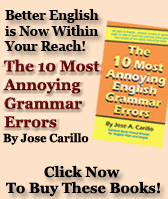- HOME
- ENGLISH FORUM
- BADLY WRITTEN, BADLY SPOKEN
- GETTING
TO KNOW ENGLISH - POUR OUT YOUR MIND IN ENGLISH
- GOING DEEPER INTO ENGLISH
- YOU ASKED ME THIS QUESTION
- EDUCATION AND TEACHING FORUM
- ADVICE AND DISSENT
- MY MEDIA ENGLISH WATCH
- NOTABLE WORKS BY OUR VERY OWN
- ESSAYS BY JOSE CARILLO
- ABOUT JOSE CARILLO
- TIME OUT FROM ENGLISH GRAMMAR
- NEWS AND COMMENTARY
- BOOKSHOP
- ARCHIVES
ESSAYS BY JOSE CARILLO
On this webpage, Jose A. Carillo shares with English users, learners, and teachers a representative selection of his essays on the English language, particularly on its uses and misuses. One essay will be featured every week, and previously featured essays will be archived in the forum.
Weaning ourselves from a wrongheaded use of “between”
There’s usually no problem when people use “between” as a stand-alone preposition to mean “from one to another,” as in “There’s no secret between us,” or to mean “something shared or in common to,” as in “The inheritance was divided between the patriarch’s four sisters.” But when it comes to “between” in the sense of “setting the limits or endpoints of a range,” many young professional writers often flub the usage. Seemingly from force of habit, they would write, say, “The taipan’s fortune is estimated between P50 billion to P60 billion,” where, of course, the preposition “to” need to be replaced by the conjunction “and” to make the grammar of the sentence beyond reproach: “The taipan’s fortune is estimated between P50 billion and P60 billion.”
It was the high incidence of such faulty usage in manuscripts for intended for publication that prompted me to write the essay below, “A recurrent misuse of ‘between’,” late last year in my column in The Manila Times. I hope that reading this essay could help wean off more people from this wrongheaded preposition usage that, if committed repeatedly, could mark them as less than grammar-savvy English writers or speakers.
Click on the title below to read the essay.
One grammar error I frequently encounter in my work as a copy editor is the misuse of the preposition “between” in the sense of setting the limits or endpoints of a range. This usage of “between” being so basic in English (as in “between you and me” and “between heaven and earth”), I used to think that getting it wrong was simply due to oversight by the writer or to what we might charitably call a typing error. But over the past three years or so, my coming across this grammar transgression much too often has convinced me that there’s actually more to the problem than meets the eye.
Consider the following sentences (I have changed some particulars to protect the identity of the writers): “Putting up a water refilling station requires an initial capital outlay of anywhere between P600,000 to P1.1 million.” “Plain chocolate contains between 30 percent to 70 percent cocoa solids.” “Each shop can carry between 1,000 to 1,800 items, with groceries comprising the bulk of its sales.” “The tunnel provided the perfect setting for the locals, who could only go partying between 8 a.m. to 4 p.m. because of the curfew.” “The estimated investment recovery period for the restaurant is between one to three years.” “His distributorship moves between 1,000 to 2,500 units a month.”
In all of the six “between”-using sentences above, of course, the grammatically acceptable usage is not “between _______ to_______” but “between _______ and _______” instead: “Putting up a water refilling station requires an initial capital outlay of anywhere between P600,000 and P1.1 million.” “Plain chocolate contains between 30 percent and 70 percent cocoa solids.” “Each shop can carry between 1,000 and 1,800 items, with groceries comprising the bulk of its sales.” “The tunnel provided the perfect setting for the locals, who could only go partying between 8 a.m. and 4 p.m. because of the curfew.” “The estimated investment recovery period for the restaurant is between one and three years.” “His distributorship moves between 1,000 and 2,500 units a month.” This is because in all of the six sentences, the “between”-phrase is describing not the range itself but a point somewhere within that range.
Now, for those who’d rather use “to” because they feel queasy using “and” as go-between for the endpoints of the range, there’s a perfectly acceptable alternative: get rid of “between” and replace it with the preposition “from,” and, if possible, get rid of “from” itself afterwards. The original five sentences will then read as follows: “Putting up a water refilling station requires an initial capital outlay of anywhere from P600,000 to P1.1 million.” “Plain chocolate contains from 30 percent to 70 percent cocoa solids.” “Each shop can carry 1,000 to 1,800 items, with groceries comprising the bulk of its sales.” “The tunnel provided the perfect setting for the locals, who could only go partying from 8 a.m. to 4 p.m. because of the curfew.” “The estimated investment recovery period for the restaurant is one to three years.” “His distributorship moves 1,000 to 2,500 units a month.”
Note that the third, fifth and sixth sentences above did away with “from” and are none the worse for it. In all six sentences, though, it’s clear that the phrase at hand is describing not a particular point within that range but the range itself.
There’s one other thing to make sure of when converting an erroneous “between _______ to _______” phrase to a “from _______ to _______” phrase in which the endpoints are dates: don’t change the “to” to a hyphen. When correcting, say, “The business flourished between 1995 to 2007, then floundered during the 2008 economic meltdown,” avoid reconstructing the sentence as “The business flourished from 1995-2007, then floundered during the 2008 economic meltdown.” For clarity and elegance in construction, always spell out the “to”: “The business flourished from 1995 to 2007, then floundered during the 2008 economic meltdown.”
From the weekly column “English Plain and Simple” by Jose A. Carillo in The Manila Times, November 15, 2008 issue © 2008 by the Manila Times Publishing Corp. All rights reserved.
----
Previously Featured Essay:
There was a time when the spread of false information took a much slower and largely linear path. A jealous or enraged person concocts a lie against a perceived enemy, whispers the lie to a neighbor’s ear ostensibly in the strictest of confidence but certain that in no time at all, that neighbor will break that confidence and whisper the same lie to another neighbor, who, in turn, can be expected to ensure that the process gets repeated ad infinitum. The lie then acquires an attractive reality of its own. Still, there was a downside to the process. Word of mouth was relatively slow, so even the most resourceful prevaricator needed at least a few days or weeks to fan the tiny flame of a lie to a major conflagration.
Modern communications technology has changed all that. These days, radio and TV, the daily papers, landline and mobile telephony, e-mail, and now even the mechanisms of the law itself make disinformation as fast as blabbering a sound-bite over the broadcast networks, punching the “Send” key of a cellular phone or computer keyboard, or filing fabricated charges against one’s target in a fiscal’s office. Organized deception has become a thriving industry, ruthlessly exploiting the inherent vulnerabilities of the very same mechanisms that make democracy possible.
This is clearly manifest in the current election campaign. Every seeker of public office is a prime target. Both the good and the bad are fair game for political demolition. Each of them—whether a true leader, visionary, zealot, crackpot, or nincompoop—is prey to the dangerous phenomenon described by the British psychologist R. H. Thouless in his “Law of Certainty”: “If statements are made again and again in a confident manner, then their hearers will tend to believe them quite independently of their soundness and of the presence or absence of evidence for their truth.”
Thouless has pinned down one fundamental flaw of the human psyche: its profound tendency to believe statements based on repetition instead of actual evidence. Of course, few would take pleasure in the notion that even the intelligent and more discerning among us can be so gullible, but other investigators have validated the “Law of Certainty” and have come up with even more disturbing corollaries: (1) The exposure effect, demonstrated by Borstein in 1989, which states that repeated exposure of people to a stimulus results in the enhancement of their attitude toward it; (2) The twin repetition-validity effect and the frequency-validity effect, established by Brown and Nix in 1996, the first confirming that belief in a supposed truth increases with repeated exposure to it, and the second, that the rated truth of a stimulus is determined by how often it is repeated; and (3) The truth effect, demonstrated by Schwartz in 1982, which states that when messages of questionable truth value are repeated, their repetition tends to move their truth-value ratings toward the truer end of the scale.
The “Law of Certainty” and its corollaries are, of course, the principal tools of ideologues, religious extremists, and political propagandists in foisting untruths in the minds of their targets. They know that by sheer repetition, the feeble resistance of rationality soon caves in and crumbles. This is why in this election campaign season, practically all of the communication channels in our midst are bristling with deceptive messages. Their financiers and practitioners have no time to lose and everything to gain, and can take comfort in the fact that the effort costs so little and that the laws against it are so weak and inutile.
Now, the big question we have to ask ourselves is this: Shall we be sitting ducks to these blatant deceptions? What is our defense against the syndicated lie and half-truth? Thouless gave us what I think is a sound course of action: be thoughtful and skeptical, and adopt a position of caution when there’s reasonable cause for doubt about a particular assertion. In plainer terms, we should never, ever make a fool of ourselves by taking scurrilous political messages at their face value.
So the next time we see a derogatory blind item in the papers, a slanderous e-mail in our electronic mailbox, or a poison text message on our cellular phone, we should not honor it even with a single thought. We should resist the temptation to pass it on. We should stop it on its tracks by skipping it or by zapping it with the “Delete” button. That’s the only way we can run the character assassins out of business. If we don’t, who knows, they just might succeed in getting us to elect people who will send this country further down the road to perdition.
From the weekly column “English Plain and Simple” by Jose A. Carillo in The Manila Times, March 27, 2004 issue © 2004 by the Manila Times Publishing Corp. All rights reserved.
----
Click to read more essays (requires registration to post)







